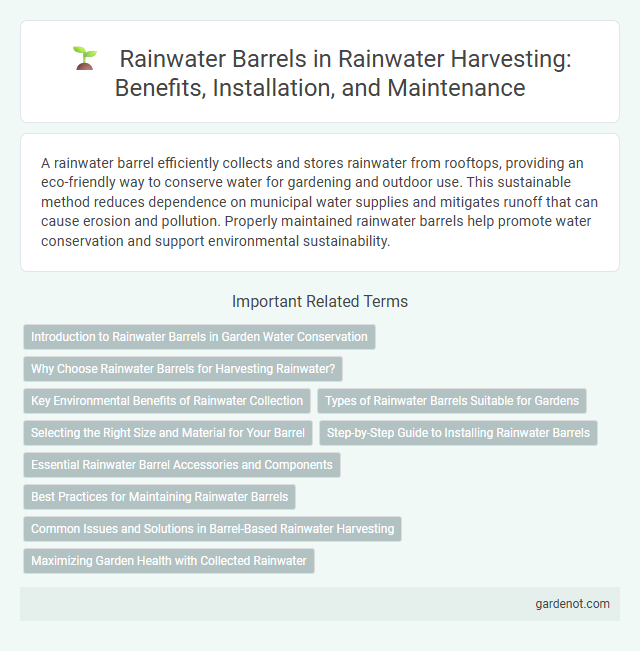A rainwater barrel efficiently collects and stores rainwater from rooftops, providing an eco-friendly way to conserve water for gardening and outdoor use. This sustainable method reduces dependence on municipal water supplies and mitigates runoff that can cause erosion and pollution. Properly maintained rainwater barrels help promote water conservation and support environmental sustainability.
Introduction to Rainwater Barrels in Garden Water Conservation
Rainwater barrels are essential tools in garden water conservation, designed to collect and store rainwater from rooftops for later use. These barrels reduce dependence on municipal water supplies, lower water bills, and provide plants with natural, chemical-free hydration. Properly installed rainwater barrels can capture hundreds of gallons per rainfall, promoting sustainable gardening and efficient water management.
Why Choose Rainwater Barrels for Harvesting Rainwater?
Rainwater barrels efficiently capture and store runoff from rooftops, reducing dependence on municipal water and lowering utility bills. They provide an eco-friendly solution for irrigation and gardening, promoting water conservation during dry periods. Using rainwater barrels helps mitigate stormwater runoff, decreasing soil erosion and protecting local waterways from pollution.
Key Environmental Benefits of Rainwater Collection
Rainwater barrels significantly reduce stormwater runoff, decreasing the risk of erosion and water pollution by capturing and storing rainwater for later use. This collected water minimizes dependence on municipal supply, conserving precious groundwater resources and reducing energy consumption associated with water treatment and distribution. Utilizing rainwater barrels fosters sustainable water management practices, promoting healthier ecosystems and enhancing urban resilience to climate change impacts.
Types of Rainwater Barrels Suitable for Gardens
Rainwater barrels suitable for gardens include plastic, wooden, and metal types, each offering unique benefits for rainwater collection and plant irrigation. Plastic barrels are lightweight, affordable, and resistant to rust, making them a popular choice for efficient water storage. Wooden barrels provide natural insulation and aesthetic appeal, while metal barrels offer durability and long-lasting performance, ideal for sustainable garden watering systems.
Selecting the Right Size and Material for Your Barrel
Choosing the appropriate size for a rainwater barrel depends on your roof's catchment area and average rainfall, with common capacities ranging from 50 to 100 gallons to ensure sufficient water storage. Opting for materials like UV-resistant BPA-free plastic or galvanized steel guarantees durability and prevents contamination, making your barrel safe for gardening and irrigation purposes. Properly sized and constructed barrels optimize rainwater collection efficiency and prolong the lifespan of your rainwater harvesting system.
Step-by-Step Guide to Installing Rainwater Barrels
Installing rainwater barrels involves selecting a suitable location near a downspout, ensuring the ground is level and stable to support the barrel's weight when full. Connect the barrel to the downspout using an appropriate diverter or downspout adapter, and install an overflow valve to direct excess water away from your foundation. Secure a spigot near the bottom of the barrel for easy water access, and incorporate a fine mesh screen on top to filter debris and prevent mosquito breeding.
Essential Rainwater Barrel Accessories and Components
Essential rainwater barrel accessories include a downspout diverter, which directs water flow efficiently from gutters into the barrel while preventing overflow. A fine mesh screen is crucial to filter debris and keep mosquitoes out, maintaining clean water storage. Additionally, a spigot or tap at the base allows easy access for water retrieval and hose attachment, ensuring practical usability.
Best Practices for Maintaining Rainwater Barrels
Regularly clean the rainwater barrel and filter system to prevent algae growth and debris buildup that can clog outlets. Ensure the barrel is covered with a fine mesh screen to keep out insects and prevent mosquito breeding. Inspect connections and seals periodically to avoid leaks and maintain water quality for irrigation or other non-potable uses.
Common Issues and Solutions in Barrel-Based Rainwater Harvesting
Rainwater barrels often face common issues such as mosquito breeding, overflow during heavy rainfall, and sediment buildup affecting water quality. Installing screens or tight-fitting lids prevents mosquito entry, while overflow outlets and diverters manage excess water effectively. Regular cleaning and the use of first-flush diverters reduce sediment accumulation, ensuring safer and more efficient water storage.
Maximizing Garden Health with Collected Rainwater
Using a rainwater barrel to collect and store rainwater provides plants with natural, chemical-free hydration that enhances soil nutrient retention and promotes healthy root growth. Regularly irrigating your garden with harvested rainwater reduces dependence on municipal water, lowering water bills and conserving resources. Proper placement of the barrel near garden beds and maintaining clean collection systems maximize water quality and availability for sustainable garden health.
Rainwater barrel Infographic

 gardenot.com
gardenot.com